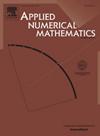利用辛克配位法和双指数变换求解二维时变薛定谔方程
IF 2.2
2区 数学
Q1 MATHEMATICS, APPLIED
引用次数: 0
摘要
在过去的四十年中,Sinc方法以其简单和优异的性能在数值分析中占有重要的地位。将Sinc配点法与双指数变换相结合,求解二维随时间变化的Schrödinger方程。通过对双指数法和单指数法的数值比较,说明了双指数Sinc法的优越性。本文章由计算机程序翻译,如有差异,请以英文原文为准。
Solving the two-dimensional time-dependent Schrödinger equation using the Sinc collocation method and double exponential transformations
Over the last four decades, Sinc methods have occupied an important place in numerical analysis due to their simplicity and great performance. An incorporation of the Sinc collocation method with double exponential transformation is used to solve the two-dimensional time dependent Schrödinger equation. Numerical comparison between the double exponential and single exponential approaches is made to illustrate the superiority of the double exponential Sinc method.
求助全文
通过发布文献求助,成功后即可免费获取论文全文。
去求助
来源期刊

Applied Numerical Mathematics
数学-应用数学
CiteScore
5.60
自引率
7.10%
发文量
225
审稿时长
7.2 months
期刊介绍:
The purpose of the journal is to provide a forum for the publication of high quality research and tutorial papers in computational mathematics. In addition to the traditional issues and problems in numerical analysis, the journal also publishes papers describing relevant applications in such fields as physics, fluid dynamics, engineering and other branches of applied science with a computational mathematics component. The journal strives to be flexible in the type of papers it publishes and their format. Equally desirable are:
(i) Full papers, which should be complete and relatively self-contained original contributions with an introduction that can be understood by the broad computational mathematics community. Both rigorous and heuristic styles are acceptable. Of particular interest are papers about new areas of research, in which other than strictly mathematical arguments may be important in establishing a basis for further developments.
(ii) Tutorial review papers, covering some of the important issues in Numerical Mathematics, Scientific Computing and their Applications. The journal will occasionally publish contributions which are larger than the usual format for regular papers.
(iii) Short notes, which present specific new results and techniques in a brief communication.
 求助内容:
求助内容: 应助结果提醒方式:
应助结果提醒方式:


